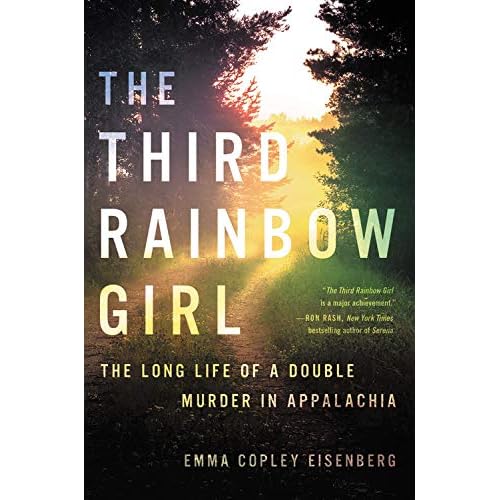Book Details Title: The Third Rainbow Girl: The Long Life of a Double Murder in Appalachia | |
Book DescriptionReview Apple Books, “Best Books of January”Amazon, “Best Books of January 2020” in Nonfiction and HistoryAmazon, “10 Best Mysteries & Thrillers of the Month”Indie Next Pick for February 2020O Magazine, “16 of the Best Books to Read this January!” Electric Lit, “20 Most Anticipated Debuts of Early 2020”The Millions, “Most Anticipated: The Great First-Half 2020 Book Preview! “Library Journal, “Editors’ Fall Picks for 2019”Publishers Weekly, “New True Crime Books 2019-2020”Southern Independent Bookseller Association, “Okra Pick for Winter 2020”SheReads, “Most Anticipated Memoirs of 2020”Esquire, “The Best Books to Elevate Your Reading List in 2020” “Headlines only deliver digestible tropes: Backcountry hicks confront hippie celebrants, two dead. But for the indefatigable Emma Eisenberg, approaching the murders at Briery Knob is about more than who fired the gun. An affection for this law-resistant corner of West Virginia enables her to transcend the simple formula of white male rage. Stepping into darkness, she extracts a nuanced sense of place and draws a map with historical connections.”―Nancy Isenberg, New York Times bestselling author of White Trash: The 400-Year Untold History of Class in America“Part crime narrative and part soul-searching memoir, Emma Copley Eisenberg’s The Third Rainbow Girl has so much wisdom to offer. It’s about the corrosiveness of preconceived notions, and about how trauma ripples through cultures and generations, and about finding connections in others and strength in oneself. Rich in detail and sensitivity and intelligence and honesty, this is a book you won’t want to put down, one that will stay with you for a long time.”―Robert Kolker, New York Times bestselling author of Lost Girls: An Unsolved American Mystery“Emma Copley Eisenberg has written a true crime book that brings to mind Truman Capote’s masterpiece In Cold Blood: elegantly written, perfectly paced, and vividly realized people and places. Equally impressive is her refusal to condescend to the inhabitants of the Appalachian community where the crimes occurred. The Third Rainbow Girl is a major achievement.”―Ron Rash, New York Times bestselling author of Serena“I blazed through this book, which is a true crime page-turner, a moving coming-of-age memoir, an ode to Appalachia, and a scintillating investigation into the human psyche’s astounding and sometimes chilling instinct for narrative. A beautiful debut that will stay with me for a long time, whose story mesmerizes even as it convinces you to find all mesmerizing stories suspect.”―Melissa Febos, Lambda Literary Award winner and author of Whip Smart and Abandon Me “Emma Eisenberg has distinguished herself as a reporter of remarkable wisdom and conscience, and her powers are on full display in The Third Rainbow Girl. Eisenberg’s meticulous, compassionate reporting does not promise any of the easy answers we might expect from true crime: neither about what happened to the “Rainbow Girls,” nor about poverty, injustice, and the fate of outsiders-whether hippies, hitchhikers, carpet baggers, or journalists-who give and take in this country’s poorest areas. Her insights are hard won, deep, and devastating, making this an unforgettable debut.”―Alice Bolin, author of Dead Girls: Essays on Surviving an American Obsession“The Third Rainbow Girl succeeds on two levels: first, as a deep dive inquiry into the 1980 murders of two young women in Pocahontas County, West Virginia, and the ensuing, tangled investigation, and second, as an intimate and humane portrait of a close-knit Appalachian community, the kind of place that is often reduced by outsiders to little more than a cliché of itself. As Jimmy Breslin once wrote of the legendary New York chronicler, Damon Runyan, ‘He did what all great reporters do … he hung out.’ A remarkable book.”―Richard Price, New York Times bestselling author of Lush Life“The Third Rainbow Girl is a staggering achievement of reportage, memoir, and sociological reckoning. We are better for this brilliant, gorgeous, and deeply humane book.”―Carmen Maria Machado, National Book Award Finalist and author of Her Body and Other Parties“In The Third Rainbow Girl: The Long Life of a Double Murder in Appalachia, Emma Copley Eisenberg uses the unsolved 1980 murders of Vicki Durian, 26, and Nancy Santomero, 19, in Pocahontas County, WV, as a lens through which to consider the effects of violent acts on the communities where they occur.”―Library Journal“The Third Rainbow Girl is a fascinating hybrid work of true crime and memoir… In following the twists and turns of the case, Eisenberg paints an affectionate portrait of Appalachia that complicates and contradicts stereotypes about the region.”―Shelf Awareness Read more About the Author Emma Copley Eisenberg is a writer whose work has appeared in Granta, VQR, McSweeney’s, Tin House, The Paris Review online, The New Republic, Salon, Slate, and elsewhere. Her work has been supported by the Millay Colony for the Arts, the Elizabeth George Foundation, Lambda Literary, and the New Economy Coalition. Her reporting has been recognized by GLAAD, the New York Association of Black Journalists, the Deadline Club and Longreads’ Best Crime Reporting 2017. Eisenberg lives in Philadelphia, where she co-directs Blue Stoop, a community hub for the literary arts. Read more Customers Review: Bought this based on a NYT review, so I have only myself to blame. The author is a navel-gazer who is shocked, absolutely shocked, that the justice system is deeply flawed. Like so many outsiders she fell in love with Appalachia. As a former criminal defense investigator, I found nothing too unusual about the bungled investigation by short-sighted cops and prosecutors. A completely unsympathetic man was falsely convicted. It happens every day. This is a memoir with maybe 15% devoted to the crime, investigations, and trials. If you want to read a memoir by someone with an agenda, buy the book, but anyone looking to read the true crime genre should skip it unless you want to read about the author’s alcohol and intimacy problems. | |

